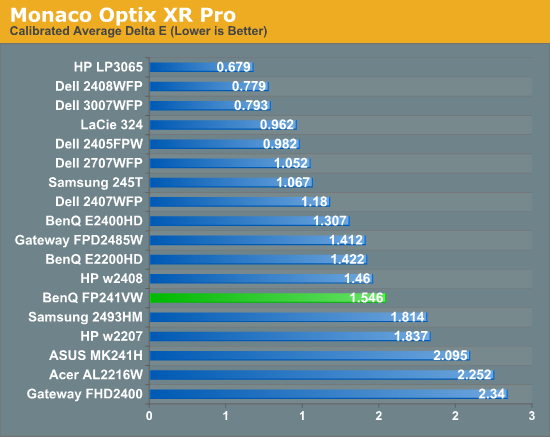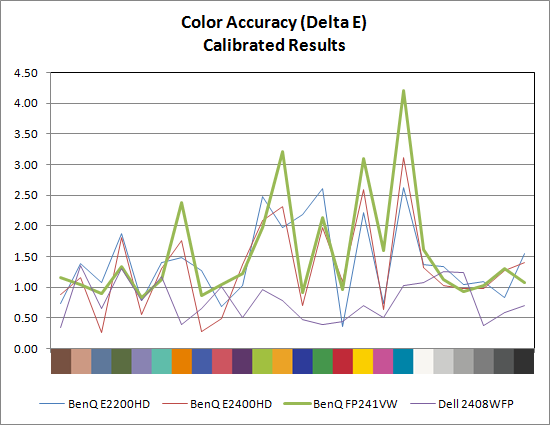Color Accuracy
Imaging professionals definitely like to have accurate colors, and the best way of assuring that your display shows the proper colors is to use a colorimeter and calibration software. However, not everyone has access to such tools and many users are unwilling to spend over $200, so we calibrate and test the various LCDs. We didn't perform a thorough evaluation of color accuracy on the FP241VW, so we will limit our Delta E comparison to calibrated performance where we target a white level of ~200 nits - anything more than that is too bright in our opinion. The FP241VW actually ended up at 270 nits, but that won't substantially affect any of the scores. Before we get to the results, here are the display settings we used on the BenQ LCDs. We let the LCDs stabilize for at least one hour before performing measurements. We will compare results with the Dell 2408WFP, which so far has achieved the best overall color accuracy of any LCD we have tested, as well as the previous two BenQ LCDs.
| LCD Brightness and Contrast Settings | ||
| Standard Calibrated (~200 nits) | Calibrated for Print (~100 nits) | |
| BenQ E2200HD | 65 Brightness, 50 Contrast "Normal" (95-95-95 RGB) |
20 Brightness, 50 Contrast "Normal" (95-95-95 RGB) |
| BenQ E2400HD | 73 Brightness, 50 Contrast "Normal" (94-94-91 RGB) |
30 Brightness, 50 Contrast "Normal" (94-94-91 RGB) |
| BenQ FP241VW | 35 Brightness, 50 Contrast (270 nits) "Normal/sRGB" (47-48-45 RGB) |
N/A |


After calibration, the FP241VW still fails to come anywhere close to the Dell 2408WFP - and in fact it doesn't even match the accuracy of the less expensive E2400HD. That said, it's interesting to note that the color accuracy curves for all three BenQ LCDs are extremely similar, to the point where I now have to wonder if backlighting has a far greater impact on color accuracy than I previously thought. It makes sense that better backlighting would allow the panels to achieve better color accuracy, but I don't have any evidence for this assertion other than the above chart. Anyone serious about color accuracy is probably going to want an average Delta E of around 1.0 or less post-calibration. So far, only S-PVA and S-IPS panels achieve that goal, although it's possible a better backlight would allow the A-MVA display to match the other displays. Note also how the bottom half of the above chart is dominated by LCDs that use TN panels.










114 Comments
View All Comments
Gazz - Friday, June 19, 2009 - link
I am useing a samsung 2493HM and have no problems at all with the monitor plays games fantastic although I have the speakers disconected Too small for what I am useingBUT it is hard to find one anymore so I checked out the Samsung site and found a range of monitors T220R,T240R,T260R with out speakers but it does not say what pannels they use
JarredWalton - Saturday, June 20, 2009 - link
The http://www.anandtech.com/displays/showdoc.aspx?i=3...">2493HM is a TN panel, so you really can't get any "worse" in terms of panel type. There are better and worse TN panels, of course, and the 2493HM was actually good as far as TN goes. Like other TN, it also doesn't have any perceptible lag, which is another plus. If you're happy with the 2493HM, you should be okay with most other displays, provided they do well in other areas.fredsnotdead - Friday, June 19, 2009 - link
"... an apparently single-minded focus on reducing costs and pricing ..."Unfortunately, that seems to be all we Americans are interested in.
Geraldo8022 - Friday, June 19, 2009 - link
I am someone who lives "off the grid". I get my power from solar and while I now have quite a number of panels and batteries I still want low power consumption. I wish more manufacturers would be more truthful about how much power their monitors use. I would like to see the websites who test monitors test the power consumption in variety of ways and consistently.I read a lot of gripes about monitors. It is surprising to me that there are not websites devoted exclusively to monitors.
darklight0tr - Friday, June 19, 2009 - link
You mean like this one?http://tftcentral.co.uk/">http://tftcentral.co.uk/
Its a pretty good site.
Geraldo8022 - Friday, June 19, 2009 - link
Yes, I have followed that site, darklight. I think it is very good. It is the only one I know of.Jarred, thanks for that info. All I have to go on are things like the specifications at the 'Egg. Good to know.
I realize power consumption can only be so low and most are interested in other aspects. I am interested in those things, too, Just weigh things differently.
JarredWalton - Friday, June 19, 2009 - link
I usually test power draw, Geraldo, but neglected to do that with this LCD. Usually, the max power draw they list (<95W) is at least 50% higher than it what I've measured. I'd expect this LCD to consume more like ~60W at full brightness, or 50-55W with the brightness calibrated to around 200 nits.Mumrik - Friday, June 19, 2009 - link
"The reference Monitor is an HP LP3065, which we have found to be one of the best LCDs we currently possess in terms of not having display lag. (The lack of a built-in scaler probably has something to do with this.) While we know some of you would like us to compare performance to a CRT, that's not something we have around our offices anymore."Buy one then!
JarredWalton - Friday, June 19, 2009 - link
Sorry, but no. It serves no point other than to add a large, heavy item to my already crowded office. I'm not comparing with CRTs because 99% of people aren't using or buying CRTs. Either a display has less lag than the LP3065 or it has more lag; it is merely a reference point. If you want to read about how LCDs compare to CRTs, plenty of sites have attempted to cover that topic.james jwb - Thursday, June 18, 2009 - link
At least one high profile site that can actually make a difference is paying this issue some attention, and i have to thank you for that!I particularly like the last part of the article which looks to the future, as in my opinion we still haven't hit a quality stage that truly knocks on CRT's door. Sure, in term of viewing angles, colour, brightness, etc, it's all there, and you can't deny the benefits of LCD's (foot print, etc). But 60hz is just plain poor and i honestly cannot wait for it to fade off the planet. 120hz is vastly superior.
One last thing. It's possible most of these TN film users who just "don't care" about the sacrificial quality never came from a background of using high quality CRT's. It's very difficult, even today, to move from a 21" professional CRT to ANY LCD and not feel you've compromised in some areas, namely the smooth and snappy response these things have. I have a feeling 120hz will bridge the gap far enough that it'll be very hard to notice any downsides to LCD technology over CRT's. But for a 24" LCD to have 120hz, its going to need display port (or at least, not DVI), and with hardly any graphics cards supporting this yet, what TFT maker would introduce one? They are certainly coming, but right now, as you rightly say, the tech is there, ready and waiting, but the market isn't.